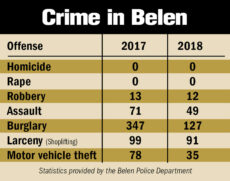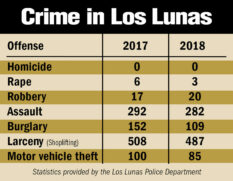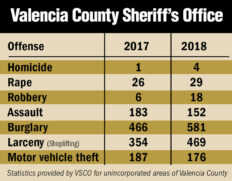Burglaries in Belen down by 37 percent
By Clara Garcia, News-Bulletin Editor
BELEN — Belen Police Chief Victor Rodriguez reported that crime in the Hub City is on the decline — most notably in the areas of burglaries and motor vehicle theft.
During a recent city council meeting, Rodriguez reported the city hasn’t had a homicide or rape in the past two years, and one more robbery in 2018 compared to 2017. Last year, there were 12 robberies, compared to 13 in 2017.
“Assaults were down from 71 incidents to 49, and burglaries were significantly down from 347 to 127,” Rodriguez said. “The amount of larcenies went down … and motor vehicle thefts dropped from 78 to 35.”
The chief said the number of narcotics incidents in the city went down slightly from 44 to 42, criminal damage reports also declined from 123 in 2017 to 85 in 2018.
The number of DWI arrests also decreased from 43 to 29.
There were a total of 843 arrests made in the city of Belen in 2018, while 674 people were taken into custody the year before.
As the number of traffic crashes in the city decreased from 303 to 241, the number of citations given to motorists also declined, from 4,309 in 2017 to 3,910 last year.
“Why did some of these incidents decrease?” Rodriguez asked. “I want to give you guys a couple of possible explanations, including habitual offenders. One burglar can be responsible for 6, 7 or even 10 burglaries in one day. Over the last year, the Belen Police Department has worked really hard to apprehend habitual offenders.”
The department’s community relationships the officers have formed, including crime education, has helped in decreasing the number of burglaries in the city. Using social media and putting information in the newspaper are just some of the measures the BPD is working on to help prevent crime.
“All those things are very positive and beneficial for our community to prevent burglars and thieves from getting into homes and vehicles,” Rodriguez said. “They are very affective measures.”
Proactive policing is a significant factor in the decrease in crime, the chief said. Belen police officers are very proactive with traffic enforcement, which Rodriguez says is huge in deterring burglaries, motor vehicle thefts and other crimes.
“The other thing that might be a reason for the decrease in crime is the lack of reporting,” he said. “Sometimes, people who are victims of crime might not know to report, or others might just not report it to police for some other reason.”
Another impact on the crime statistics might have to do with officer vacancies in the department.
“Officer vacancies do impact these numbers in the areas of burglaries, narcotics, DWIs and citations because if there are less officers on the streets, the less proactive we can be,” Rodriguez said. “Nine times out of 10, DWIs are usually officer generated, and when you don’t have the officers on the streets, the less likely they’ll be able to find them.”
The new chief gives kudos to the officers of the Belen Police Department, who he says are doing a “great job” and who are arresting more people.
Rodriguez is trying to figure out how the department is using the department’s crime management system, making sure they have accurate numbers.
“I want to make sure we’re using accurate numbers, accounting for multiple offenses, that we’re not duplicating offenses, and if three officers are writing a report on the same incident, that we’re not counting those as three different incidents,” Rodriguez said. “Those are the things I’m going to look for.”
Councilor Frank Ortega asked if the police department could hold quarterly meetings with the city to see what are the most prevalent crimes and where they are happening.
“Any type of transparency … is very important,” the chief said. “The residents need to know what’s going on in their community.”
Councilor Wayne Gallegos was also concerned about the crime statistics the FBI puts out, saying the city has been categorized as one of the worst in the state. He’s been told the crimes within the 87002 zip code are being lumped into the city of Belen’s stats.
“The numbers are as good as the person entering the data,” Rodriguez said. “That’s one thing I’m going to look at.
“Every community in New Mexico is experiencing the same dilemma that Belen is experiencing — the lack of officers, the fluctuation of crime,” he said. “It’s not unique to Belen and I recognize that. We have a very proactive police department.”
Crime in Los Lunas decrease 8 percent
By Clara Garcia, News-Bulletin Editor
LOS LUNAS — As the village of Los Lunas continues to grow, overall crime rates have decreased by 8 percent. Los Lunas Police Chief Naithan Gurule attributes the decline to the department’s traffic enforcement efforts.
“All year long, our officers have worked really hard in taking reports and hitting areas of concern with traffic enforcement,” Gurule said. “They’re out, they’re visible. They’re not necessarily giving traffic citations, but they’re stopping people, making contact and educating the public.”
By being visible with traffic enforcement, LLPD Deputy Chief Vince Torres said they are letting people know they need to slow down, wear their seat belts, while taking into account the totality of the stop before taking any type of enforcement action.
The two veteran lawmen say by having more police patrolling neighborhoods and the business districts, officers are being noticed by potential criminals who might be looking at homes or businesses to target.
“From these traffic stops, several have turned into drug arrests,” Gurule said. “An officer might see some type of evidence, which would turn into the vehicle being towed and searched. They’re finding drugs, and they’re finding weapons.”
That information could lead to narcotics investigations within the village, and sometimes in the county and other municipalities. Working with other local law enforcement is vital, which the chief says has already benefited the LLPD.
“We are working with the new sheriff (Denise Vigil), who worked with us before in our criminal investigations,” Gurule said. “Just having the relationship in place already is extremely beneficial to all our residents.
“Since she took over, we’ve met a few times and discussed what our plans are for us to move forward together regarding narcotics and violent crimes,” he said. “We also work with Bosque Farms, and now with the new chief in Belen. People are going to see a big difference. There’s a willingness to work together that we haven’t had in a long time. You can feel the motivation and excitement to make a difference.”
Torres said Sheriff Vigil has also expressed interest in combining the department’s monthly community meetings with LLPD, which he says would be more about Valencia County rather than just Los Lunas.
Because they’ve noticed an increase in narcotics, motor vehicle thefts and violent crimes associated with the two, Gurule said Lt. Lisa Valenzuela successfully obtained a COPS grant, which effectively paid for two additional officers who focuses on tracking the stats.
“They would hit the neighborhoods at specific times on specific days and make traffic stops, which we think helped with the decrease,” Gurule said. “The whole state is experiencing a problem with motor vehicle thefts.”
The total number of motor vehicle thefts in Los Lunas decreased from 100 to 85 in 2018.
The department has also focused its efforts on narcotics investigations, working cases in the village and with the DEA and sharing information with Albuquerque police.
The number of burglaries in the village decreased from 152 in 2017 to 109 in 2018. There were three fewer reported rapes reported last year than the year before in the village, while the number of robberies increased by three, from 17 to 20. The number of assaults decreased slightly from 292 to 282, as well as the number of larceny cases — 508 to 487.
There was an increase in the number of DWI cases from 2017, as the LLPD arrested 104 people, compared to 2018 when 111 drivers were taken into custody.
“The increase for us is not a negative thing,” the chief said. “We have a unit dedicated just to DWI enforcement. We know that its out there, and we’ve also seen an increase in marijuana-related DWI arrests.”
The department is fortunate to have Lt. Charles Files, who is the state’s drug recognition expert, as well as to other officers who are DREs. Gurule said these officers are specially trained to recognize and perform specialized tests on motorists who might be under the influence of drugs, such as marijuana, heroin and other narcotics.
“Being DRE’d certified, they know what signs to looks for,” Torres said.
“If you don’t have the training, it makes it more difficult in identifying it, which results in less arrests,” Gurule said. “We’ve been hitting the DWI issues hard with three people dedicated to this. Last month during our DWI checkpoint, we arrested two people for being under the influence of marijuana as well as for a stolen vehicle.”
Gurule said traffic and DWI enforcement is the main factor in reducing crime in the village because the officers are visible, making traffic stops and talking to people.
“As soon as you reduce traffic enforcement, you’re going to see other crimes go up,” he said. “That’s the key.”
In total, the Los Lunas Police Department has 40 officers, with six detectives, and two vacancies, which the chief says they are in the process of filling.
“We’ve been very fortunate with vacancies,” Gurule said. “We haven’t the issue that some of the other agencies have had with officers leaving for the larger agencies.
“We’ve been able to add six positions in the last several years,” Torres said. “The COPS programs pays three-quarters ($202,847) of the salary for two officers for a period of three years, and then after that, the village has to absorb the cost.”
Gurule said alternative revenue, or grants, is important to the department, especially for officer training. In the past year, the LLPD has obtained several grants, including the Work Innovation Opportunities Act, which is reimbursed $24,859 to the department when they hire, promote or send an officer to training based on the certain guidelines established for the program. The department was also awarded $25,500 in traffic safety grant funding for traffic safety projects, such as checkpoints from the state.
“The reason we’re so successful is because we have so many good people,” Gurule said. “Our officers are probably the best in the state and they work extremely hard every day and that’s why we’re seeing a reduction in crime.”
(Editor’s note: A story about Bosque Farms’ crime statistics will be published in next week’s News-Bulletin.)
Crimes reported in county increase
By Julia M. Dendinger, News-Bulletin Assistant Editor
In the last 12 months, the Valencia County Sheriff’s Office has been lacking manpower and that is the immediate focus of the new sheriff and her administration.
“We have taken a hit in the last year and lost a few deputies to other agencies,” said Valencia County Sheriff Denise Vigil. “It has been difficult to purse extra projects at this time. I will say this — when we get past the staffing issue, we will be utilizing our CRIT team to address the drug problems in Valencia County. We all know that problem causes the burglaries, shoplifting, stolen vehicles and many other crimes.”
The sheriff said the department has one new deputy already enrolled in the state law enforcement academy, and a second who will go through this summer. There are also three certified officers in the interview process.
In addition to the focus on hiring, Vigil hopes to collaborate with Bosque Farms, Belen and Los Lunas police departments to work together on issues they’re experiencing.
“When you put all your resources together, you can make a bigger impact,” Vigil said. “I have spoken with the chiefs from the surrounding agencies, and we are all after the same goal.”
Officers are being patient during the restaffing, she said, but the department’s sergeants and deputies are looking for relief.
“They are out doing their job and serving the community, so hiring more deputies is on the top of the list,” Vigil said. “We commend them for what they do. I am pleased to say I have received numerous phone calls commending the deputies on a job well done.
“It also tells us that the field sergeant is doing his part with his deputies. We, in administration, also like hearing this. It tells they are doing what they took an oath to do.”
Undersheriff Mark Kmatz said the department’s force is down by about 40 percent, which limits how proactive deputies can be.
“They just can’t be as proactive as we’d like,” Kmatz said. “We’re in the same situation as other local agencies. We can’t compete with Albuquerque and state police. It is something we’re working to address.”
Vigil said the department will be presenting a proposal to the Valencia County Commission asking for some additional funding.
“To show we care about staff and to be at least comparable to Sandoval and Santa Fe counties,” she said. “Hopefully, this will help us hire deputies and retain the ones we have.”
In years past, with higher staffing levels and violent crimes few and far between, Detective Sgt. Curtis Espinoza said the department could be proactive, which helped keep other types of crime down.
“But the busier we get, the more reactive we’ve become,” Espinoza said.
When asked why the department was busier in recent years, Lt. James Harris said it was his personal belief that older, criminal shot-callers were back on the streets and rebuilding.
“Several years back, a lot of violent people were put in prison. Now 10, 15 years later, they are coming out of prison and becoming active again,” Harris said. “They are active and rebuilding the gang life and we’re seeing more violent crimes.”
VCSO’s criminal investigation division is comprised of four deputies, a sergeant and a lieutenant, Espinoza said, and handles cases from homicides to assaults, crimes against children to sex crimes.
“Larger departments do have special units to handle specific crimes, like homicides,” Harris said.
Members of the CID serve as their own crime scene technicians, Espinoza said.
“They are trained to collect evidence, but they have to do that and interview victims and take witness statements as well,” Espinoza said.
How a crime, such as a homicide, is investigated varies from case to case, the detective said. For instance, after a recent homicide in El Cerro Mission, a suspect was identified, charged and arrested in a matter of days.
“Other times, we have very little information and we have to wait for someone to come forward,” he said.
Once a victim has been positively identified, detectives interview family and friends and any known associates.
“All the people that person was involved with, anyone who had a specific problem with the victim,” Harris said. “That can be difficult sometimes, if the person isn’t from here.”
Evidence collected is sent to the crime lab in Santa Fe.
“But they are dealing with requests from every other agency in the state,” Espinoza said.
Harris added they can request expedited processing, but that is determined by the lab.
“We do a lot of crime scene investigation and is a major job of law enforcement,” Harris said. “The reality is we are not going to walk into a crime scene in Valencia County, find a hair and solve the crime.
“Yes, forensics plays a big part in investigating crimes as does DNA evidence, but it’s not the be all, end all. In a lot of cases, it’s old fashioned investigating, asking questions and identifying suspects.”
Homicide cases don’t close, he said.
“One could sit for years and if we get new evidence, we move forward,” Harris said. “We can have a suspect for a while, but it’s not what you ‘know,’ it’s what you can prove.”
Julia M. Dendinger began working at the VCNB in 2006. She covers Valencia County government, Belen Consolidated Schools and the village of Bosque Farms. She is a member of the Society of Professional Journalists Rio Grande chapter’s board of directors.




















